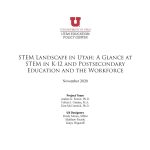

Published: November 2020
Researchers:
Andrea K. Rorrer, Ph.D.
Felicia Onuma, M.A.
Kim McCormick, Ph.D.
UX Designers:
Brody Moore, MStat
Matthew Pecsok
Katya Wagstaff


Published: November 2020
Researchers:
Andrea K. Rorrer, Ph.D.
Felicia Onuma, M.A.
Kim McCormick, Ph.D.
UX Designers:
Brody Moore, MStat
Matthew Pecsok
Katya Wagstaff
The interconnectedness of the K-12, postsecondary, and workforce spheres is apparent in investigations concerning science, technology, engineering, and mathematics (STEM). Research indicates that students in the K-12 arena who receive a rigorous education and ample exposure to science and mathematics are significantly more likely than their counterparts to enroll in a four-year university, pursue a major in a STEM field, and graduate with a bachelor’s degree [1-3]. Students who earn a baccalaureate or postgraduate STEM degree are generally more sought in the workforce, particularly in today’s era of technological innovation and fierce global competition that is increasingly reliant on individuals who possess the so-called 21st century skills, which includes the ability to analyze, evaluate, design, and create evidence-based solutions to problems [1].
Here we provide Phase I of the STEM Landscape in Utah through an interactive dashboard. First, we provide an overview of STEM policies and initiatives enacted between 1999 and 2019. Next, using secondary data sources, we provide a longitudinal overview of STEM education, participation, and outcomes within K-12, postsecondary, and the workforce. The dashboard also permits an understanding of the state’s progress on important STEM related outcomes, including how these outcomes vary by gender, race/ethnicity, and Free or Reduced Lunch status. Where possible we also compare Utah data to national trends. This dashboard will be expanded as additional data become available and accessible.
Phase I of the companion dashboard was developed by the Utah Education Policy Center in partnership with the STEM Action Center and Boeing.
Data used for the dashboard were gathered from a variety of secondary sources, including the National Assessment of Educational Progress (NAEP), the STEM Action Center, the U.S. Bureau of Labor Statistics (BLS), the Utah Data Research Center (UDRC), the Utah Department of Workforce Services, the Utah State Board of Education (USBE), and the Utah State System of Higher Education (USHE). Data obtained from the USBE and UDRC were transformed to generate some of the descriptive statistics that are presented in the dashboard. Data from additional secondary sources were sometimes summarized or used as obtained. All tables and figures were generated by the Utah Education Policy Center. Data sources are cited throughout the dashboard.
For a detailed overview of the analyses performed to derive the data presented in each chart, please visit this link.
Secondary data accessed to inform these dashboards were gathered under the guidance of Data Share Agreements with the Utah State Board of Education and the Utah Data Research Center. In keeping with the UEPC’s Data Share Agreement with UDRC, we are providing the following disclaimer: Some of the data for this research was accessible through Utah’s state longitudinal data system database administered by the Utah Data Research Center, which includes data supplied by UDRC members. This research, including the methods, results, and conclusions neither necessarily reflect the views of, nor are endorsed by, the UDRC members. All errors are the responsibility of the author.
The Utah Education Policy Center (UEPC) extends gratitude to Dr. Tamara Goetz, Executive Director, and Clarence Ames, STEM Program Specialist, from the STEM Action Center for their consultation on this project. The UEPC also acknowledges Vincent Brandon and Jeremias Solaris at the Utah Data Research Center for their assistance in navigating the UDRC data request and review process, and the peer reviewers at both the Utah State Board of Education and the Utah System of Higher Education.
References
1. Walston, J., & McCarroll, J. C. (2010). Eighth-grade algebra: Findings from the eighth-grade round of the Early Childhood Longitudinal Study, Kindergarten Class of 1998-99 (ECLS-K), Statistics in Brief. NCES 2010-016. Washington, DC: National Center for Education Statistics.
2. Zelkowski, J. (2010). Secondary Mathematics: Four credits, block schedules, continuous enrollment? What maximizes college readiness?. The Mathematics Educator, 20(1), 8-21.
3. Jang, H. (2016). Identifying 21st century STEM competencies using workplace data. Journal of Science Education and Technology, 25(2), 284-301.
4. Eligible CIP Codes for the STEM Opt Extension, Department of Homeland Security (DHS)
5. STEM Designated Degree Program List, Department of Homeland Security (DHS)